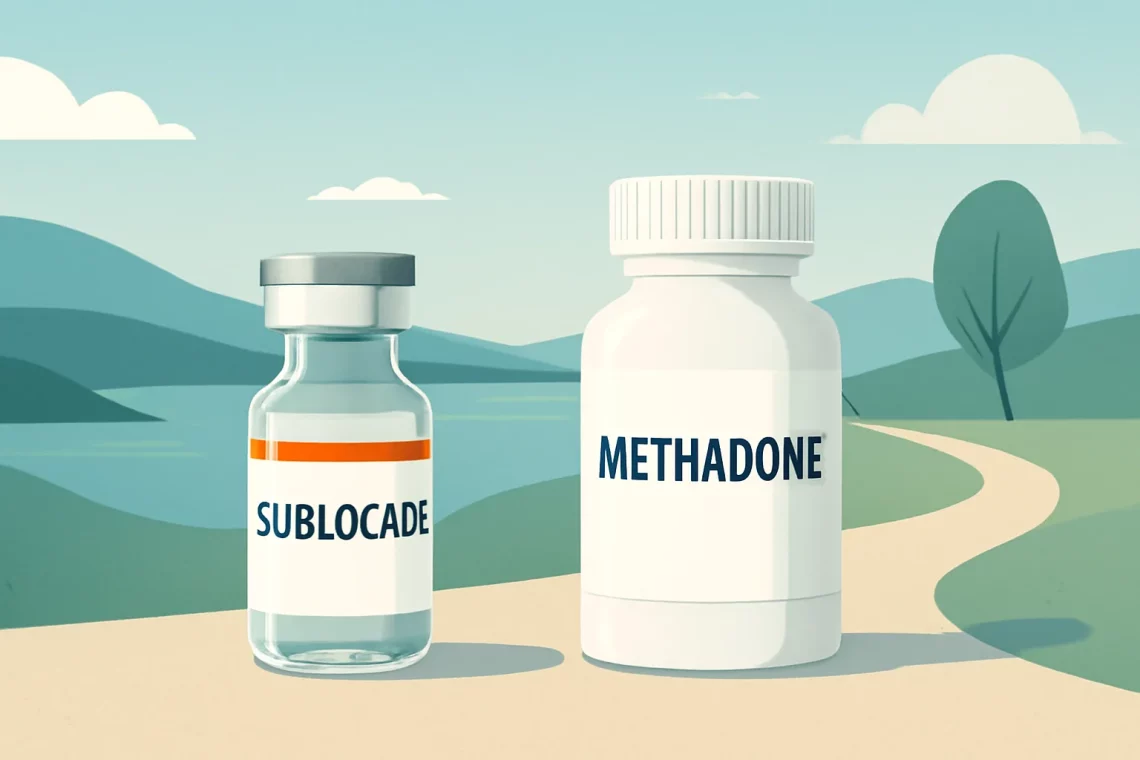
Sublocade vs Methadone: Which Treatment is Right for You?
The opioid crisis has become a significant public health concern, leading to an increased need for effective treatment options for individuals struggling with opioid use disorder. Among these options, two treatments have gained considerable attention: Sublocade and methadone. Both therapies aim to alleviate withdrawal symptoms and cravings, helping patients regain control of their lives. However, they differ in their formulations, administration methods, and overall effectiveness.
Sublocade is a relatively newer medication that delivers buprenorphine in a long-acting injectable form. This novel delivery system allows for once-monthly administration, which can enhance adherence and reduce the risk of misuse. On the other hand, methadone has been a cornerstone of opioid addiction treatment for decades, administered orally in a liquid form and requiring daily visits to a clinic for supervision in many cases.
As the fight against opioid addiction continues, understanding the nuances of these two treatment modalities is crucial for patients, healthcare providers, and policymakers alike. This exploration into Sublocade and methadone will help illuminate the benefits and challenges associated with each, ultimately contributing to informed decisions about addiction treatment.
Sublocade: An Overview
Sublocade is a brand-name medication that contains buprenorphine, a partial opioid agonist used in the treatment of opioid use disorder. It is administered as a subcutaneous injection, offering a long-lasting therapeutic effect that can last for up to 30 days. This innovative approach aims to improve patient compliance, as it eliminates the need for daily dosing and frequent clinic visits.
The method of action for Sublocade involves binding to the same opioid receptors in the brain as other opioids, but with a ceiling effect that reduces the risk of overdose. This means that while it can effectively alleviate withdrawal symptoms and cravings, it does so with a lower potential for misuse compared to full agonists like heroin or prescription opioids.
One of the significant advantages of Sublocade is its convenience and ease of use. Patients can receive their injection once a month, which can significantly reduce the burden of daily medication management. This is particularly beneficial for individuals who may have difficulty adhering to a daily regimen due to various life circumstances, including work commitments or transportation issues.
Moreover, the long-acting nature of Sublocade can help stabilize patients more effectively, providing a steady level of medication in the system. This stabilization can lead to improved quality of life and a greater likelihood of success in recovery. However, it’s important to note that Sublocade is only available through certified treatment programs, and administration must be performed by a healthcare professional.
Despite these benefits, Sublocade does have some limitations. For instance, it may not be suitable for everyone, particularly those with certain medical conditions or those who are not already stabilized on a lower dose of buprenorphine. Additionally, while the injection is less prone to misuse, there are still risks associated with opioid use, and patients must remain vigilant.
In conclusion, Sublocade represents a significant advancement in the treatment of opioid use disorder, providing a convenient and effective option for many patients. However, it is essential for individuals to consult with healthcare providers to determine if this treatment is appropriate for their specific situation.
Methadone: A Traditional Approach
Methadone has been a cornerstone in the treatment of opioid use disorder for many years. As a full agonist, methadone binds to opioid receptors in the brain, effectively reducing withdrawal symptoms and cravings. Unlike buprenorphine, methadone does not have a ceiling effect, which means that higher doses can be administered to manage more severe cases of addiction.
One of the defining characteristics of methadone treatment is its administration method. Patients typically receive their doses in a clinic setting, which may require daily visits. This structured approach is designed to monitor patients closely and prevent misuse. The clinic environment also provides additional support services, including counseling and group therapy, which can enhance the overall effectiveness of the treatment.
While methadone has proven to be effective for many individuals, there are challenges associated with its use. The requirement for daily clinic visits can be a barrier for some patients, making it difficult for them to maintain employment or manage other responsibilities. Additionally, the potential for misuse and overdose remains a concern, particularly in unregulated settings.
Despite these challenges, methadone continues to be a viable option for many individuals struggling with opioid addiction. It has a long track record of effectiveness and is often used in conjunction with other therapeutic interventions. The combination of medication and counseling can provide a comprehensive approach to recovery, addressing both the physical and psychological aspects of addiction.
Moreover, methadone can be particularly beneficial for individuals with a history of severe opioid use, as it can help stabilize them and reduce the risk of relapse. For many, it serves as a bridge to recovery, allowing them to regain control over their lives and make positive changes.
In summary, methadone remains a critical tool in the fight against opioid addiction. Its long-standing history of use and proven effectiveness make it an essential option for many patients. However, as with any treatment, it is crucial for individuals to work closely with healthcare providers to determine the best approach for their unique situations.
Comparing Effectiveness and Safety
When comparing Sublocade and methadone, it’s essential to consider their effectiveness and safety profiles. Both treatments aim to reduce withdrawal symptoms and cravings, but they do so through different mechanisms and delivery methods.
Sublocade’s long-acting formulation allows for consistent medication levels in the body, which can lead to improved patient outcomes. Studies have shown that patients receiving Sublocade may experience lower rates of relapse and improved adherence to treatment compared to those on traditional oral medications. The convenience of monthly injections can also reduce the chances of missed doses, a common issue with daily medications.
On the other hand, methadone has a well-established history of efficacy. It has been used for decades and is backed by extensive research demonstrating its effectiveness in stabilizing individuals with severe opioid use disorders. Methadone’s ability to be titrated to higher doses can be particularly advantageous for patients with higher levels of dependence, allowing for tailored treatment plans.
Safety is another crucial aspect to consider. Sublocade’s partial agonist properties mean that there is a lower risk of overdose compared to full agonists like methadone. However, both medications carry risks, and individuals must be monitored closely, especially during the initial phases of treatment.
Additionally, the setting in which each medication is administered plays a role in safety. Methadone is typically provided in a clinical environment, which allows for real-time observation and support. Sublocade, while administered by healthcare professionals, may not have the same level of oversight post-injection, as patients are not required to return until their next scheduled dose.
In conclusion, both Sublocade and methadone present unique advantages and potential drawbacks. The choice between the two should be made on an individual basis, taking into account the specific needs and circumstances of the patient, as well as the recommendations of healthcare providers.
Making an Informed Decision
Choosing between Sublocade and methadone is a significant decision for individuals struggling with opioid use disorder. It requires careful consideration of various factors, including personal health history, lifestyle, and treatment goals. Engaging in open discussions with healthcare providers can help patients navigate these choices effectively.
Patients should consider their preferences for medication administration. For those who prefer a less frequent dosing schedule, Sublocade may be more appealing. Conversely, individuals who feel more comfortable with daily supervision might find methadone to be a suitable option due to its structured treatment environment.
Additionally, it’s essential to assess other support systems in place. Both treatment options can be enhanced by counseling and support groups, which play a crucial role in recovery. Understanding the overall treatment plan, including behavioral therapies and support services, can significantly impact the success of either medication.
Furthermore, individuals should be aware of the potential side effects and risks associated with each treatment. While both Sublocade and methadone have been shown to be effective, they can also have adverse effects, and awareness of these can help patients make informed choices.
Ultimately, the decision should be a collaborative process involving healthcare providers, patients, and their support systems. By weighing the benefits and challenges of both Sublocade and methadone, individuals can choose the treatment that aligns best with their recovery goals and lifestyle.
In conclusion, while Sublocade and methadone each have their strengths and limitations, the right choice will depend on individual circumstances and preferences. Consulting with healthcare professionals is essential to ensure that patients receive the most appropriate and effective treatment for their needs.
**Disclaimer:** This article is not intended as medical advice. Always consult a healthcare professional for any medical concerns or treatment options.




